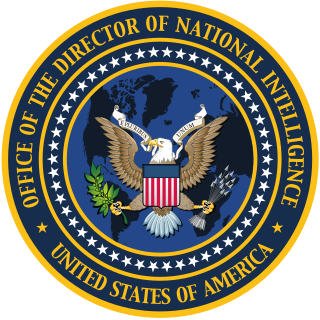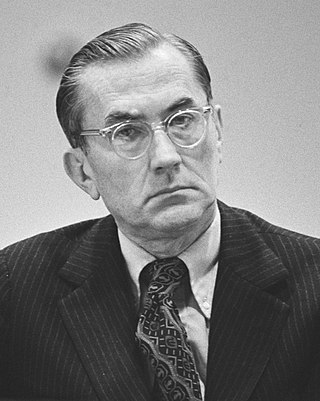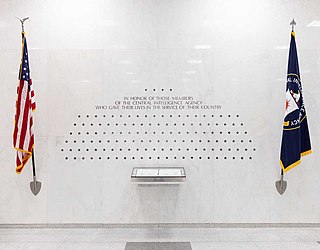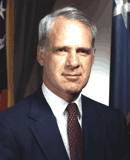
The Defense Intelligence Agency (DIA) is an intelligence agency and combat support agency of the United States Department of Defense, specializing in defense and military intelligence.

Richard McGarrah Helms was an American government official and diplomat who served as Director of Central Intelligence (DCI) from 1966 to 1973. Helms began intelligence work with the Office of Strategic Services during World War II. Following the 1947 creation of the Central Intelligence Agency (CIA), he rose in its ranks during the presidencies of Truman, Eisenhower and Kennedy. Helms then was DCI under Presidents Johnson and Nixon, yielding to James R. Schlesinger in early 1973.

The Director of Central Intelligence (DCI) was the head of the American Central Intelligence Agency from 1946 to 2004, acting as the principal intelligence advisor to the president of the United States and the United States National Security Council, as well as the coordinator of intelligence activities among and between the various US intelligence agencies.

The director of national intelligence (DNI) is a senior cabinet-level United States government official, required by the Intelligence Reform and Terrorism Prevention Act of 2004 to serve as executive head of the United States Intelligence Community (IC) and to direct and oversee the National Intelligence Program (NIP). All 18 IC agencies, including the Central Intelligence Agency (CIA), the Defense Intelligence Agency (DIA) and the National Security Agency (NSA), report directly to the DNI.

William Egan Colby was an American intelligence officer who served as Director of Central Intelligence (DCI) from September 1973 to January 1976.

The United States Intelligence Community (IC) is a group of separate U.S. federal government intelligence agencies and subordinate organizations that work both separately and collectively to conduct intelligence activities which support the foreign policy and national security interests of the United States. Member organizations of the IC include intelligence agencies, military intelligence, and civilian intelligence and analysis offices within federal executive departments.

James Rodney Schlesinger was an American economist and public servant who was best known for serving as Secretary of Defense from 1973 to 1975 under Presidents Richard Nixon and Gerald Ford. Prior to becoming Secretary of Defense, he served as Chair of the Atomic Energy Commission (AEC) from 1971 to 1973, and as CIA Director for a few months in 1973. He became America's first Secretary of Energy under Jimmy Carter in 1977, serving until 1979.

The Bureau of Intelligence and Research (INR) is an intelligence agency in the United States Department of State. Its central mission is to provide all-source intelligence and analysis in support of U.S. diplomacy and foreign policy. INR is the oldest civilian element of the U.S. Intelligence Community and among the smallest, with roughly 300 personnel. Though lacking the resources and technology of other U.S. intelligence agencies, it is "one of the most highly regarded" for the quality of its work.

The Directorate of Operations (DO), less formally called the Clandestine Service, is a component of the US Central Intelligence Agency. It was known as the Directorate of Plans from 1951 to 1973; as the Directorate of Operations from 1973 to 2005; and as the National Clandestine Service (NCS) from 2005 to 2015.
The National Intelligence Board (NIB), formerly the National Foreign Intelligence Board and before that the United States Intelligence Board is a body of senior U.S. Intelligence Community leaders currently led by the Director of National Intelligence (DNI). The Board is tasked with reviewing and approving National Intelligence Estimates (NIEs).

The Central Intelligence Agency, known informally as the Agency, metonymously as Langley and historically as the Company, is a civilian foreign intelligence service of the federal government of the United States tasked with gathering, processing, and analyzing national security information from around the world, primarily through the use of human intelligence (HUMINT) and conducting covert action through its Directorate of Operations. The agency is headquartered in the George Bush Center for Intelligence in Langley, Virginia.
Executive oversight of United States covert operations has been carried out by a series of sub-committees of the National Security Council (NSC).

After the Central Intelligence Agency lost its role as the coordinator of the entire United States Intelligence Community (IC), special coordinating structures were created by each president to fit his administrative style and the perceived level of threat from terrorists during his term.
This article deals with activities of the U.S. Central Intelligence Agency, specifically dealing with arms control, weapons of mass destruction (WMD) and weapons proliferation. It attempts to look at the process of tasking and analyzing, rather than the problem itself, other than whether the CIA's efforts match its legal mandate or assists in treaty compliance. In some cases, the details of a country's programs are introduced because they present a problem in analysis. For example, if Country X's policymakers truly believe in certain history that may not actually be factual, an analyst trying to understand Country X's policymakers needs to be able to understand their approach to an issue.
The Dulles–Jackson–Correa Report was one of the most influential evaluations of the functioning of the United States Intelligence Community, and in particular, the Central Intelligence Agency (CIA). The report focused primarily on the coordination and organization of the CIA and offered suggestions that refined the US intelligence effort in the early stages of the Cold War.
The Eberstadt Report, officially known as the Task Force Report on National Security Organization, was a study conducted by the United States government which evaluated the structure and operations of the United States Department of Defense and United States Intelligence Community. The report was created by the Task Force on National Security Organization, chaired by Ferdinand Eberstadt, from 1948–49 under the Commission on Organization of the Executive Branch of the Government, also known as the First Hoover Commission. The most important findings of the report include recommendations for better cooperation within the US Intelligence Community, improvement in the internal structure and operations of the Central Intelligence Agency (CIA), and the growing need for the development of scientific intelligence in the background of the Cold War. Despite its submission to US Congress, the report was not widely read due to being overshadowed by the Intelligence Survey Group and its report, the Dulles Report.
At various times since the creation of the Central Intelligence Agency, the Federal government of the United States has produced comprehensive reports on CIA actions that marked historical watersheds in how CIA went about trying to fulfill its vague charter purposes from 1947. These reports were the result of internal or presidential studies, external investigations by congressional committees or other arms of the Federal government of the United States, or even the simple releases and declassification of large quantities of documents by the CIA.
The Central Intelligence Agency (CIA) is a United States intelligence agency that "provides objective intelligence on foreign countries." The CIA is also informally known as the Agency, or historically informally referred to simply as "the Company". The CIA is part of the United States Intelligence Community, is organized into numerous divisions. The divisions include directors, deputy directors, and offices. The CIA board is made up of five distinct entitles called Directorates. The CIA is overseen by the Director of Central Intelligence. Under the Director of Central Intelligence is the Deputy Director of Central Intelligence. Under this the CIA is divided into four directorates. These directorates are as follows:
The Boren-McCurdy intelligence reform proposals were two legislative proposals from Senator David Boren and Representative Dave McCurdy in 1992. Both pieces of legislation proposed the creation of a National Intelligence Director. Neither bill passed into law.

The United States Central Intelligence Agency (CIA) dates from September 18, 1947, when President Harry S. Truman signed the National Security Act of 1947 into law. A major impetus that has been cited over the years for the creation of the CIA was the unforeseen attack on Pearl Harbor, but whatever Pearl Harbor's role, at the close of World War II government circles identified a need for a group to coordinate government intelligence efforts, and the Federal Bureau of Investigation (FBI), the State Department, the War Department, and even the Post Office were all jockeying for that new power.












